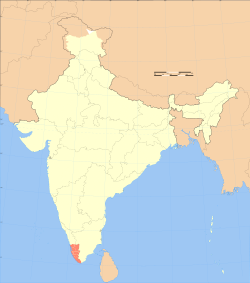Thiruvithaamkoor
| Kingdom of Travancore | ||||||||||
| തിരുവിതാംകൂർ | ||||||||||
| Princely state of Pre-Colonial India | ||||||||||
|
||||||||||
|
||||||||||
|
Anthem Vancheesamangalam (Hail the Lord of Vanchi) |
||||||||||
|
Kingdom of Travancore in India
|
||||||||||
| Capital |
Padmanabhapuram (1729–1795) Thiruvananthapuram (1795–1949) |
|||||||||
| Languages | Malayalam, Tamil | |||||||||
| Religion | Hinduism, Christianity, Islam | |||||||||
| Government | Monarchy | |||||||||
| Maharaja | ||||||||||
| • | 1729–1758 (first) | Marthanda Varma | ||||||||
| • | 1829–1846 (peak) | Swathi Thirunal | ||||||||
| • | 1931–1949 (last) | Chithira Thirunal | ||||||||
| Resident | ||||||||||
| • | 1788–1800 (first) | George Powney | ||||||||
| • | 1800–1810 | Colin Macaulay | ||||||||
| • | 1840–1860 (peak) | William Cullen | ||||||||
| • | 1947 (last) | Cosmo Grant Niven Edwards | ||||||||
| Historical era | Age of Imperialism | |||||||||
| • | Established | 1729 | ||||||||
| • | British vassal | 1795 | ||||||||
| • | Indian vassal | 1947 | ||||||||
| • | Disestablished | 1949 | ||||||||
| Area | ||||||||||
| • | 1941 | 19,844 km² (7,662 sq mi) | ||||||||
| Population | ||||||||||
| • | 1941 est. | 6,070,018 | ||||||||
| Density | 305.9 /km² (792.2 /sq mi) | |||||||||
| Currency | Travancore rupee | |||||||||
|
||||||||||
| Today part of | India | |||||||||
Princely state of the British Indian Empire
The Kingdom of Travancore (/ˈtrævəŋkɔər/; Malayalam: തിരുവിതാംകൂർ Thiruvithamkoor, was an Indian kingdom from 1729 until 1949. It was ruled by the Travancore Royal Family from Padmanabhapuram, and later Thiruvananthapuram. At its zenith, the kingdom covered most of modern-day central and southern Kerala with the Thachudaya Kaimal's enclave of Irinjalakuda Koodalmanikkam temple in the neighbouring Kingdom of Cochin, as well as the district of Kanyakumari, now in the Indian state of Tamil Nadu. The official flag of the state was red with a dextrally-coiled silver conch shell (Turbinella pyrum) at its center. In the early 19th century, the kingdom became a princely state of the British Empire. The Travancore Government took many progressive steps on the socio-economic front and during the reign of Maharajah Sri Chithira Thirunal Balarama Varma, Travancore became the second most prosperous princely state in British India, with reputed achievements in education, political administration, public work and social reforms.
...
Wikipedia



